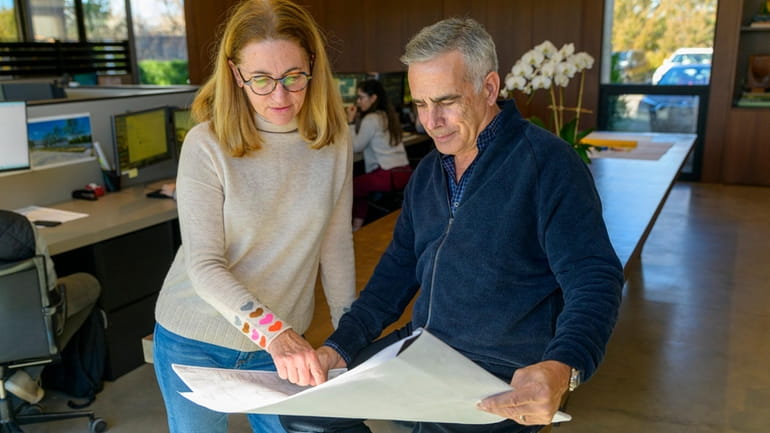From a Hamptons barn, Chris LaGuardia takes his landscaping artistry around the world

Chris LaGuardia and his, wife Jane, of LaGuardia Design Group, look over blueprints at their offices in Water Mill. Credit: /Tom Lambui
Growing up amid dairy farms and rolling hills in upstate New York, Chris LaGuardia would join his three siblings to tend to the family’s acres of land, including its gardens.
Influenced by those experiences, LaGuardia decided to become a landscape architect while majoring in horticulture at the SUNY College of Agriculture and Technology at Cobleskill. Two years later, LaGuardia, whose father sold insurance and mother taught music, entered the University of Georgia for its program in landscape design and earned his bachelor’s degree.
A summer Hamptons job with noted architect Norman Jaffe blossomed into full-time employment, stretched eight years and gave him significant site-planning experience and skills.
In 1993, after Jaffe died, LaGuardia hung out his own shingle.
AT A GLANCE
LaGuardia Design, Landscape Architects
Founder and Principal: Chris LaGuardia
Location: Water Mill
Established: 1993
Employees: 25
Annual aggregate value of landscape construction projects incorporating the firm's work: $40 million to $60 million
“I got clients through word-of-mouth and my architect friends saw that I had a specialty and wanted to collaborate with me,” he said.
Today, as the founder and principal of LaGuardia Design, Landscape Architects in Water Mill, he heads a 25-employee firm that specializes in site planning. Its work involves the optimum placement on properties of structures, including buildings, pools, tennis courts and fountains; gardens, trees and other plantings; and walkways.
“It’s a complex process of understanding topography, drainage and zoning codes,” said LaGuardia, 62. It's also year-round.
According to LaGuardia, slush, snow and ice have little, if any, bearing on his firm’s workload. The winter months, he said, are often the busiest, with the firm preparing construction drawings and specifications for work to begin in the spring. And in the heat of the summer, fall plans are underway for planting trees.
LaGuardia recently spoke to Newsday about his landscape architect business. Answers have been edited for clarity and space.
What were the early years of the business like?
I took the low-overhead approach and worked out of my house — in the basement, and eventually hired an assistant, and then another, and then my wife, Jane, who’s a partner, joined the firm. After about seven years, we moved the business from the house and into office space in Water Mill.
Where’s the business located now?
Our office is in a big barn. We built it from scratch, and we’ve been here for six years.
The property was zoned for an office, but it came with a house, which we rent to some of our employees to get them started so they can work out here.
How do you attract employees?
I give a couple of lectures a year at universities, botanical gardens and other forums, and students ask for an interview. We’re a nationally-known firm, so we also get inquiries, about one a week. And we hire interns in their third year of college, which is a test run before hiring them when they graduate.
To promote our profession at a young level and before our local kids go to college, we do high school career and shadow days [which exposes students to the field and firm].
It’s hard to get people to come out here or stay [because of] affordable housing and the winter social life can be limited. But if they already live on the East End, they see a path for themselves in the community.
Still, you’ve managed to attract employees from elsewhere.
We engage other Hamptons firms to foster a social life through industry nights and varied events. And with our New York City office, younger staff can spend some time in the city and the Hamptons.
What’s your employee retention strategy?
Our employees are long-term investments and we want them to stay. They might start out as associates, then senior associates, project managers and senior project managers. It’s a long, slow process to really master the profession, and it could take you well into your 30s.
Two of my partners, Ian Hanbach, 42, and Daniel Thorp, 39, came to the firm right out of school.
How do you generate business?
We get a lot of referrals from architects, other clients, general contractors and builders, and we work closely with nurseries.
Now that we have a brand that’s pretty well known, new clients see us in magazines, including Architectural Digest, Veranda and Interiors.
And we produced a monograph of our work: Contemporary Gardens of the Hamptons, 1990-2000, which is sold all over the world.

This project is in Sagaponack overlooking Fairfield Pond. This new residence replaced an existing structure with a resort-style swimming pool over looking a native plant restoration of the shoreline. Credit: Anthony Crisifulli
What are some of the firm’s notable projects?
Rooftop terraces in New York, a ski house in Sun Valley, Idaho, and estates in Connecticut, Rhode Island, South Florida and the Caribbean. Many years ago, we did a public park and luxury hotel in Shanghai, China.
We’re also working with golf, country and beach clubs, and right now, we’re doing site design on The Bruce Springsteen Archives and Center for American Music at Monmouth University in New Jersey.
What percentage of your projects is residential versus commercial?
Private residential represents 70% of our work, and 30% is public parks, commercial buildings, institutional and resort work.
How many projects are you working on currently?
We’ve got 150 active projects, including final construction, beginning stages of design, about to break ground, and tied up in permitting. But we have good staff and service and manage well so we can deliver in a timely manner.
What’s your biggest challenge?
We’re always under pressure to make sure the landscape performs well, and because disease and storms can destroy a landscape, it’s mostly beyond our control. But we try to keep it to a minimum.
What’s the best part of your work?
I enjoy the process of building great landscapes and watching them grow. Each of our gardens is like a child.
